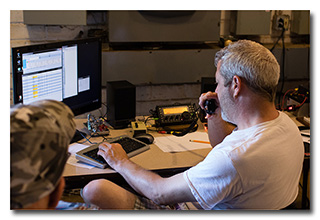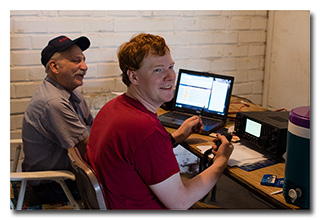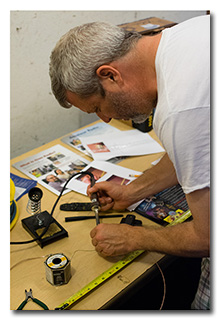by William Eric McFadden
Pictures
- A view of the Athens 9-1-1 tower on Friday before Field Day, with threatening skies behind
- KC8MSM prepares the 10-40m trap dipole for deployment
- KD8WVX prepares to deploy the 10-40m trap dipole
- Athens News reported Dennis Powell photographs the goings-on
- The Athens 9-1-1 tower, 10-40m trap dipole, and 40/80m fan dipole
- KC8KSM (left) and N8XWO (right) man the 6m station
- WD8RIF works HF CW; photo by Andy Young
- N8XWO works 6m SSB
- KD8FRQ (left) operates 6m SSB while N8XWO (right) logs
- KD8WVX operates HF SSB
- KD8WVX operates HF SSB
- N8DWB (left) operates HF SSB while KD8KNC (right) logs
- KD8WVX constructs a 2m "tiger tail" during the Educational Activity
- KD8WXV operates HF SSB while KD8KNC logs and WD8RIF and Athens Mayer Steve Patterson watch; photo by Dennis Powell
- KD8WVX grabs some shut-eye Sunday morning
- KD8KNC operates HF SSB
- A view of the WD8RIF/KD8KNC sleeping tent and the Athens 9-1-1 tower
- KD8KNC cooks Sunday breakfast
- KD8KNC (right) operates 6m SSB while KD8FRQ logs
- The HF station generator; the hard-hat protected an RFI filter from the earlier rain
- The 6m yagi
- KD8FRQ operates HF SSB
- N8XWO (left) operates HF SSB while KD8KNC (right) sleepily logs
Description
The Athens County Amateur Radio Association (ACARA) participated in the 2018 ARRL Field Day with 100-watt stations at the Athens County Fairgrounds with the callsign W8PG. For the third year running, the group was able to set up the stations inside the large brick building on the Fairgrounds for protection from weather and insects.
The club participated in class 1A, meaning one transmitter, club or non-club group, power output of 150 watts or less. A total of 561 QSOs and 1,150 bonus points resulted in a score of 2,021 points. A breakdown of QSOs per band can be found below. The ACARA earned bonus points for the following:
- 100% Emergency Power (100 points),
- Media Publicity (100 points),
- Public Location (100 points),
- Public Information Table (100 points),
- Alternate Power (100 points),
- W1AW Field Day Bulletin (100 points),
- Educational Activity (100 points),
- Site Visitation by an Elected Official (100 points),
- Site Visitation by a Representative of a Served Agency (100 points),
- Safety Officer (100 points),
- Social Media (100 points), and
- Web Submission (50 points).
 The ACARA Field Day operation took place at the Athens County Fairgrounds. Power for the HF
station came from a 2kW Honda inverter-generator and power for the the 6m VHF station came
from a 1kW Honda inverter-generator. These generators were not as environmentally-friendly
as the solar trailer used during previous Field Day operations but these modern generators
are significantly quieter, more fuel-efficient, and more reliable than less sophisticated
generators. Athens County 9-1-1 Emergency Communications Center again provided the 50'
trailer-mounted tower to support the 80m/40m fan-dipole and 10m/15m/20m/40m trap-dipole HF
antennas.
The ACARA Field Day operation took place at the Athens County Fairgrounds. Power for the HF
station came from a 2kW Honda inverter-generator and power for the the 6m VHF station came
from a 1kW Honda inverter-generator. These generators were not as environmentally-friendly
as the solar trailer used during previous Field Day operations but these modern generators
are significantly quieter, more fuel-efficient, and more reliable than less sophisticated
generators. Athens County 9-1-1 Emergency Communications Center again provided the 50'
trailer-mounted tower to support the 80m/40m fan-dipole and 10m/15m/20m/40m trap-dipole HF
antennas.
Both the HF station and the VHF station were set up in the large brick building at the Fairgrounds. The HF station consisted of an Elecraft KX3 provided by Eric McFadden, WD8RIF, and a matching Elecraft KXPA100 100-watt amplifier with KXAT100 internal ATU provided by Drew McDaniel, W8MHV. A dual-yardarm atop the 9-1-1 Center's 50' trailer-mounted tower supported an 80m/40m fan dipole and a 10m/15m/20m/40m trap-dipole as inverted-vees. The 80m legs of the fan-dipole were oriented north-to-south to provide east-west directivity and the 40m legs were oriented east-to-west to provide north-south directivity. The trap-dipole legs were oriented north-to-south orientation to provide east-west directivity.
 The VHF station consisted of an ICOM IC-7410, a homebrew two-element 6m yagi, and a homebrew
20' mast, all of which were provided by John McCutcheon, N8XWO. The yagi was aimed using a
traditional armstrong rotor.
The VHF station consisted of an ICOM IC-7410, a homebrew two-element 6m yagi, and a homebrew
20' mast, all of which were provided by John McCutcheon, N8XWO. The yagi was aimed using a
traditional armstrong rotor.
Logging for both stations was by laptop PCs running N1MM Logger+. The HF logging PC interfaced with the KX3 and tracked band and mode changes. For the second year, the HF operators took advantage of N1MM Logger+'s ability to record the operator's identity.
Friday night prior to Field Day had brought rain to Athens and Saturday brought additional rain. Fortunately, during set-up time, the rain stayed away and deployment of the antennas and generators took place without anybody getting seriously wet. (The rain, heavy at times, returned following set-up but, fortunately, the rain wasn't accompanied by lightning.)
Athens Mayor Steve Patterson accepted the invitation by Jeff Slattery, N8SUZ, to visit the Field Day operation. The mayor visited on Saturday and presented a proclamation from the City of Athens. View the proclamation: Amateur Radio Operators Appreciation Days, June 23-24, 20178
Jeff had also invited the Athens County Commissioners to visit the Field Day operation. The Commissioners did not visit the Field Day operation but they did send a signed proclamation from Athens County. View the proclamation: Amateur Radio Operators Appreciation Days, June 23-24, 2018
As a result of the press releases sent out by Josh Cash, KE8EAS, the Field Day operation was visited by Dennis Powell from The Athens News (link). An article by Mr. Powell was published in the June 28, 2018 edition of the paper: Ham Radio Field Day good fun with a serious purpose.
The goal for this year's Field Day, like that of last year, was to get new or inactive hams on the air but. unfortunately, other plans conspired to prevent the ACARA's newly-licensed hams from being able to participate. In addition, conflicting plans also kept several of the ACARA's most active members from participating in Field Day. Nevertheless, the few operators who were able to participate made 561 QSOs and had fun while doing so. David Bradley, N8DWB, made about eight HF SSB QSOs. Bob Curtis, KD8FRQ, made four HF SSB QSOs. Eric McFadden, WD8RIF, made 310 HF CW QSOs. Miles McFadden, KD8KNC, made about thirty HF SSB QSOs. Jeff Slattery, N8SUZ, made eleven HF SSB QSOs. Andy Young, KD8WVX, made 181 HF SSB QSOs. The 6m station didn't track operators but Bob Curtis, KD8FRQ; John McCutcheon, N8XWO; Miles McFadden, KD8KNC; and Bob Moore, KC8KSM all contributed to making the 6m station's twenty-one 6m SSB QSOs.
 The Educational Activity this year was a presentation by Eric McFadden, WD8RIF, entitled
"Improving 2-Meter HT Performance in Pedestrian-Mobile Applications" and included the
opportunity for those interested to build a "tiger tail" counterpoise wire for their
HTs.
The Educational Activity this year was a presentation by Eric McFadden, WD8RIF, entitled
"Improving 2-Meter HT Performance in Pedestrian-Mobile Applications" and included the
opportunity for those interested to build a "tiger tail" counterpoise wire for their
HTs.
Unfortunately, the group failed to make a successful satellite QSO this year, although this was not through lack of trying. WD8RIF and KD8WVX attempted to make a QSO during six FM-satellite passes using WD8RIF's Yaesu FT-60R and Elk 2M/440L5 dual-band log-periodic antenna. The number of stations attempting to work through the birds was significantly higher than that heard during Field Day 2016 and Field Day 2017, even during the wee-hours-of-the-morning passes. Interestingly, the same strong stations were heard dominating all six of the satellite passes. Initially, WD8RIF thought that these stations were violating Field Day rule 7.3.7.1 ("Stations are limited to one completed QSO on any single channel FM satellite") by making numerous QSOs during the multiple passes but he eventually came to realize that he hadn't heard any of them complete a single QSO; they were probably trying—and failing—to make a QSO just as he and KD8WVX were doing.
It is interesting to note that in 2016, there was just one FM satellite available (SO-50) and the ACARA group easily succeeded in making a QSO; in 2017, there were two FM satellites available (SO-50 and Lilac-Sat) and the group succeeded in making a QSO; in 2018, there were four FM satellites available (SO-50, AO-85, AO-91, and AO-92) yet traffic on the birds during six passes prevented the ACARA from completing a QSO. WD8RIF credits the increased interest in the FM satellites to the article, "Get on the Satellites for ARRL Field Day" by Sean Kutzko, KX9X, which appeared in the June, 2018 edition of QST. It would be interesting to compare this year's number of successful FM satellite QSOs with the numbers for previous years—did KX9X's article increase interest in the FM satellites so much that fewer stations met with success? WD8RIF is hoping that by Field Day 2019, one of the announced HF linear-transponder satellites will be operational.
QSOs per band:
| Band | CW | Phone |
| 80 | 55 | 4 |
| 40 | 127 | 129 |
| 20 | 94 | 80 |
| 15 | 10 | 6 |
| 10 | 24 | 11 |
| 6 | 0 | 21 |
| Satellite | 0 | 0 |
| Total | 310 | 251 |
Saturday dinner, Sunday breakfast, and Sunday lunch were again artfully provided by Miles McFadden, KD8KCN, and the Athens' Own (link) mobile kitchen.
Eric McFadden, WD8RIF, ACARA president and Field Day Chairman, wishes to thank the following who helped make this a successful Field Day:
- John Biddle, W8PG
- Josh Cash, KE8EAS
- Bob Curtis, KD8FRQ
- John McCutcheon, N8XWO
- Drew McDaniel, W8MHV
- Eric McFadden, WD8RIF
- Miles McFadden, KD8KNC
- Robert Moore, KC8KSM
- Jeff Slattery, N8SUZ
- Andy Young, KD8WVX
Eric McFadden sends very special thanks to the Athens County 9-1-1 Emergency Communications Center for the use of their 50' crank-up mobile tower.
(return)